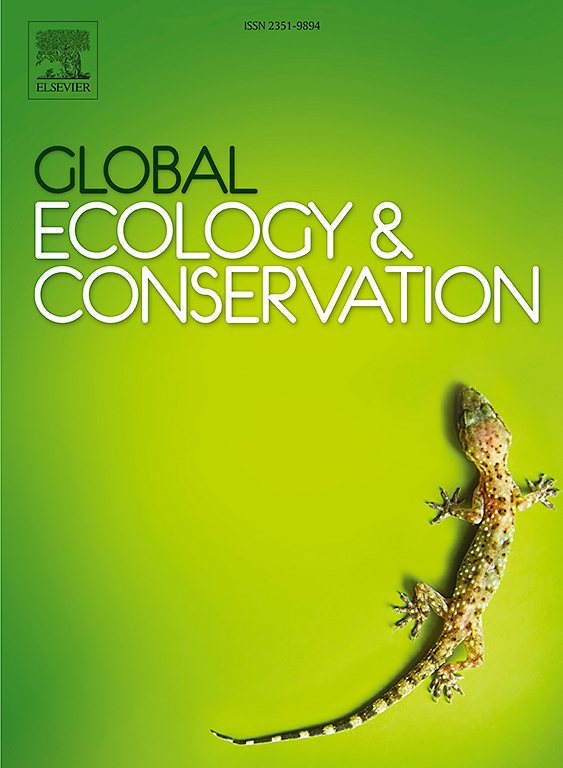它们在那里吗?农业环境计划投资如何惠及荷兰奶牛场的目标物种--以草地鸟类为例
IF 3.5
2区 环境科学与生态学
Q1 BIODIVERSITY CONSERVATION
引用次数: 0
摘要
在荷兰,农民集体为保护草地鸟类而实施的农业环境计划(AES),由于农民使用的选择和组合的多样性,造成了复杂的景观镶嵌。我们提出了一种简化这种复杂性的方法,将可能受益的草地鸟类数量作为衡量成功与否的标准,并评估 AES 组合作为货币投资的函数如何影响管理的成功。2016 年至 2022 年期间,我们进行了实地调查,测量了三种土地利用类型中黑尾鲣鸟的密度和分布情况:AES、场地保护区和集约农业。AES 农田分为巢穴保护区、淹没区、延迟割草区和草本植物丰富的草地。我们分析了这些管理方式、覆盖面积和鲣鸟数量之间的关系,同时还研究了土地面积和补贴。密集型农业覆盖了74.3%的面积,但在低密度(0.063只/公顷)的情况下,仅有23.2%的神鸟栖息于此。相比之下,保护区(占面积的 6.2%)和农业经济区(占面积的 19.5%)在较高密度(分别为 0.48 只和 0.46 只/公顷)下分别维持了 24.7% 和 52.1% 的鲣鸟数量。在农田灌溉和排水系统类型中,延迟刈割和草本植物丰富的草地的草鸥密度最高(分别为 0.66 和 1.25 只/公顷),覆盖面积较小(分别为 6 % 和 1.1 %)。这些 AES 类型支付的补贴最高,而巢穴保护支付的补贴最低,占地 10.5%,鲣鸟密度较低。虽然 AES 农田容纳了约一半的鲣鸟种群,但从面积上看,重点仍然是巢穴保护,而且集约农业在景观中占主导地位。这可能限制了在种群层面的有效性,需要重新评估保护的优先事项和资金。本文章由计算机程序翻译,如有差异,请以英文原文为准。
Are they even there? How agri-environment schemes investments reach their target species in Dutch dairy-farmland, the case of meadow birds
Agri-environmental schemes (AES) implemented by farmer collectives for meadow bird protection in The Netherlands create complex landscape mosaics due to the variability of options and combinations farmers use. We propose a method to simplify this complexity, using the number of meadow birds potentially benefiting as the measure of success, and evaluate how AES combinations affect management success as a function of monetary investments. Between 2016 and 2022, we conducted field surveys to measure the density and distribution of Black-tailed Godwits across three land-use types: AES, site-protected areas, and intensive agriculture. AES fields were categorized into nest protection, inundation, delayed mowing, and herb-rich grasslands. We analysed the relationship between these managements, the area they cover, and godwit numbers, while also examining land area and subsidies. Intensive agriculture covered 74.3 % of the area but hosted only 23.2 % of the godwit population at low densities (0.063 godwits/ha). In contrast, protected areas (6.2 % of the area) and AES fields (19.5 %) supported 24.7 % and 52.1 % of the population at higher densities (0.48 and 0.46 godwits/ha, respectively). Among AES types, delayed mowing and herb-rich grasslands showed the highest godwit densities (0.66 and 1.25 godwits/ha, respectively) covering smaller areas (6 % and 1.1 %). These AES types pay the highest subsidies, while nest protection, covering 10.5 % of the area with lower godwit densities, pays the lowest. Although AES fields hosted about half of the godwit population, area-wise the focus remained on nest protection, and with intensive agriculture dominated the landscape. This may limit effectiveness at a population level, calling for re-evaluating conservation priorities and funding.
求助全文
通过发布文献求助,成功后即可免费获取论文全文。
去求助
来源期刊

Global Ecology and Conservation
Agricultural and Biological Sciences-Ecology, Evolution, Behavior and Systematics
CiteScore
8.10
自引率
5.00%
发文量
346
审稿时长
83 days
期刊介绍:
Global Ecology and Conservation is a peer-reviewed, open-access journal covering all sub-disciplines of ecological and conservation science: from theory to practice, from molecules to ecosystems, from regional to global. The fields covered include: organismal, population, community, and ecosystem ecology; physiological, evolutionary, and behavioral ecology; and conservation science.
 求助内容:
求助内容: 应助结果提醒方式:
应助结果提醒方式:


